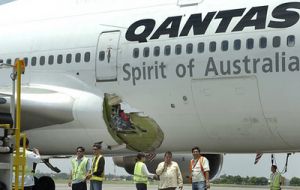MercoPress. South Atlantic News Agency
Qantas Boeing 747 with a hole of an emergency landing

A hole the size of a small car in the underside of a Qantas jumbo jet carrying 346 passengers forced the pilot to make an emergency landing Friday after a rapid descent over the South China Sea
The Boeing 747-400 was cruising at 29,000 feet when a loud bang rattled the plane. Video shot by a passenger shows people sitting with their oxygen masks on as the jet descended quickly to 10,000 feet. Applause erupted as the plane touched down safely An official at the U.S. Transportation Security Administration, who spoke on condition of anonymity because the incident was not domestic, said initial reports show it was not related to terrorism. "From the pictures coming in from Manila it's quite evident that a section of the fuselage gave way in flight," Jane's Aviation Expert Chris Yates said in a statement. "As a consequence of this the aircraft experienced rapid decompression. Fast action from the pilot and co-pilot ensured that all those aboard remained safe." Investigators will now determine whether metal fatigue or manufacturing defect caused the panel to be ripped away from the remainder of the fuselage in flight, Mr. Yates said. The aircraft appeared to be missing a plate of its metal skin at the joint where the front of the right wing attaches to the plane. A curved line of rivets was still visible on the body at the front edge where the sheet once was; a straight line of rivets is along the other. Flight QF 30, from London to Melbourne, had just made a stopover in Hong Kong. "One hour into the flight there was a big bang, then the plane started going down," passenger Marina Scaffidi, 39 years old, from Melbourne, told the Associated Press by phone from Manila airport. "There was wind swirling around the plane and some condensation." She said the hole extended from the cargo hold into the passenger cabin. June Kane of Melbourne described how parts of the plane's interior broke apart in the depressurized cabin. "There was a terrific boom and bits of wood and debris just flew forward into first [class] and the oxygen masks dropped down," she told Australia's ABC Radio. "It was absolutely terrifying, but I have to say everyone was very calm." A report by the Manila International Airport Authority, quoting pilot John Francis Bartels, said the plane suffered an "explosive decompression." Australia's air-safety investigator said an initial investigation suggested "a section of the fuselage separated." Bob Vandel, executive vice president of the independent, Virginia-based Flight Safety Foundation, said the hole caused the plane to lose pressure and oxygen, which required the pilot to start a quick, initial descent to normalize oxygen levels, said Mr. Vandel. "The plane lost pressure, so the pilot had to get the aircraft down below 12,000 feet pretty quickly," said Mr. Vandel. Geoff Dixon, the chief executive officer of Qantas, praised the pilots and the rest of the 19-person crew for how they handled the incident. "This was a highly unusual situation and our crew responded with the professionalism that Qantas is known for," he said. Qantas -- Australia's largest domestic and international airline -- boasts a strong safety record and has never lost a jet to an accident, although there were crashes of smaller planes, the last in 1951. Since then, there have been no accident-related deaths on any Qantas jets. However, the airline has had a few scares in recent years. In February, a Qantas 717 with 84 passengers on board sustained substantial damage in a heavy landing in Darwin, Australia. In addition, union engineers -- who have held several strikes this year to demand pay raises -- say that safety is being compromised by low wages and overtime work. Late Friday, the passengers boarded another plane for Melbourne. The damaged plane was towed to a hangar in Manila. Chief Superintendent Atilano Morada, head of the police Aviation Security Group, said his officers, including explosives experts, may assist in the airline's investigation. "So far, they don't want us to touch it, so we will respect the aircraft owner. But we will make our personnel available if they need assistance in the investigation," he said. The incident carried some echoes of a 1988 incident in which a large section of an older Aloha Airlines jetliner was torn off over Hawaii because of metal fatigue. Although the pilots were able to land, a flight attendant died and many of the 89 passengers were seriously injured.




Top Comments
Disclaimer & comment rulesCommenting for this story is now closed.
If you have a Facebook account, become a fan and comment on our Facebook Page!